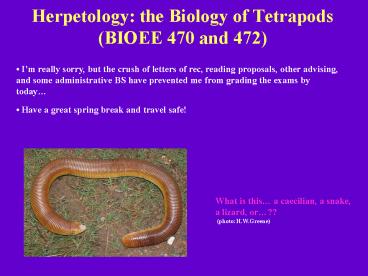Herpetology: the Biology of Tetrapods BIOEE 470 and 472 PowerPoint PPT Presentation
1 / 19
Title: Herpetology: the Biology of Tetrapods BIOEE 470 and 472
1
Herpetology the Biology of Tetrapods (BIOEE 470
and 472)
Im really sorry, but the crush of letters of
rec, reading proposals, other advising, and some
administrative BS have prevented me from grading
the exams by today Have a great spring break
and travel safe!
What is this a caecilian, a snake, a lizard,
or?? (photoH.W.Greene)
2
Lepidosauria
Generalized amniotes, other lineages
(Testudines, Archosauria) more grossly derived
Tuatara and Squamata (Lacertilia, Amphisbaenia,
Serpentes) Transverse vent, looser skull than
in turtles and crocodylians How can something
with no legs be a tetrapod?
Giant Amphisbaenian (Amphisbaena alba),
Brazil (PhotoH.W.Greene)
3
Lepidosauria Tail Autotomy
Intra-vertebral fracture planes Muscles
originate and insert across vertebrae Blood
vessels with sphincter valves near fracture
planes Regenerated tail has cartilaginous rod
and usually is shorter, with imperfect
scalation Skinks retrieve autotomized fat
stores Evolutionarily lost in snakes and some
other lepidosaurs
Upper fracture planes, autotomized tail, and
tail stump (from Bellaris, The Life of
Reptiles) Lower Ground Skink (Scincella
lateralis) escaping from a Milksnakes
(Lampropeltis triangulum) (photoB.E.Dial)
4
LepidosauriaTuatara
Rhyncocephalia or Sphenodontida, two species of
Sphenodon are living fossils Low
temperature, slow life-style (see text) No
hemipenes, but possible homologs Endemic to
New Zealand, endangered and super-protected
5
Squamata Two Penes!
The other, much more speciose branch of living
Lepidosauria Hemipenis is a misnomer because
they were misunderstood in the 18th century, not
"half of a penis Blind tube, sulcus
spermaticus, and a retractor muscle how does it
work? Hemipenes are used alternately and each
one drains the ipsilateral testis, so
6
Squamata Two Penes!
Systematic variation Preparation for
scientific study Hemiclitori as homologs of
hemipenes and vice versa Could there be gender
bias in the workings of science, even something
as arcane as herpetology?
Crotalus (photoC.W.Painter)
7
Lizards as basal squamates tongues
Primitive fleshy blob, food prehension and
tastefound in Tuatara and Iguania Two-part
tongue anterior specialized for chemoreception,
posterior manipulates food in mouth found in
Scleroglossa, more often nocturnal, limbless,
wide-foraging, and feed on large prey less often
territorial Snakes have the anterior tongue
specialized for vomeronasal chemoreception
Sphenodon tongue (photoK.Schwenk)
Amphisbaena alba (photoH.W.Greene)
8
Lizard Diversity Iguania and Scleroglossa
Amniota Mammalia Reptilia
Testudines Archosauria
Lepidosauria Spenodon
Squamata Iguania
Iguanidae
Agamidae Chameleonidae
Scleroglossa
(other lizards, amphisbaenians, snakes)
Could you draw a phylogenetic tree, with labeled
nodes and terminal taxa, based upon this
classification?
9
Lizards as basal squamates size
Sphaerodactylus semasiops, 50 mm TL, lt1 g
(photoS.B.Hedges) Varanus komodoensis, gt3 m,
100 kg Megalania prisca, 7-8 m, 600 kg
(illustration from Kadimakara) Most lizards
are 10-20 cm, 10-100 g Most snakes are bigger
than most lizards!
10
Lizards as basal squamates Teeth
Generalized insectivores with simple, conical
teeth Herbivores with flattened, multi-cuspate
teeth Durophagous species with molariform
teeth Carnivores with elongate, recurved,
sometimes serrated teeth
Upper Gerrhonotus infernalis (Anguidae) middle
Iguana iguana (Iguanidae) lower left Dracaena
lower right Tupinambis (both Teiidae) (photosH.W
.Greene)
11
Lizards as basal squamates Tails
Locomotion propulsion, sculling, balance,
grasping, gliding Fat storage e.g.,
Coleonyx Social ventral bars, tail displays,
etc. Defense spines, whips, chemical sprays,
autotomy (Scincella lateralis)
Bare-footed Gecko, Coleonyx switaki (photoH.W.Gre
ene)
12
Lizards as basal squamates Feet
Lamellae and setae (about half a million on
each toe, see text)
Rhacodactylus leachianus, Gekkonidae, New
Caledonia (photoH.W.Greene)
13
Lizards as basal squamates Feet
Triangular fringes in desert sand dwellers
(Iguanidae, Agamidae, Gekkonidae, Cordylidae,
Lacertidae, and Scincidae) Rectangular fringes
in water runners (Iguanidae and Agamidae)
Upper Uma (photoG.Merkor) middle and bottom
Hydrosaurus (photosH.W.Greene)
14
Lizards as basal squamates Feet
Zygodactyly (fused toes) Only in
Chameleonidae
Namib Desert Chameleon, Chameleo
namaquensis (photoM.PgtFogden)
15
Lizards as basal squamates Major Deviations
Often rampantly convergent Nocturnality
Specialized diets and morphology Locomotion,
defense, viviparity Body elongation, limb
loss, and multiple evolution of snakiness
Moloch, Moloch horridus (PhotoM.P.Fogden)
16
Lizard Diversity Iguania and Scleroglossa
Squamata is daunting! So, what are these?
Iguanians have fleshy blob tongues that apprehend
food, are typically territorial and visually
oriented, and never evolve limblessness
Scleroglossans have specialized chemosensory
tongues, apprehend food with their jaws, are
often not territorial, and frequently evolve
limblessness
Upper, Enyalius, Brazil (photoH.W.Greene)
lower, Pygopus, Australia (photoM.P.Fogden)
17
Lizard Diversity Iguanidae
Iguana iguana has dental and intestinal
adaptations for herbivory Juveniles must
ingest adult feces to gain microbes and achieve
normal growth
Iguana iguana, Costa Rica (photoH.W.Greene)
18
Lizard Diversity Iguanidae
Iguana iguana has a despot-harem social system,
and unusually socially cohesive young
Iguana iguana, Costa Rica (upper) and
Panama (PhotoH.W.Greene)
19
Lizard Diversity Iguanidae
Galapagos land (Conolophus) and marine
(Amblyrhynchus) iguanas Herbiorous relatives
of Iguana and other iguanines Both species
have stereotyped postures for soliciting grooming
from birds
(PhotosT.de la Roy)

